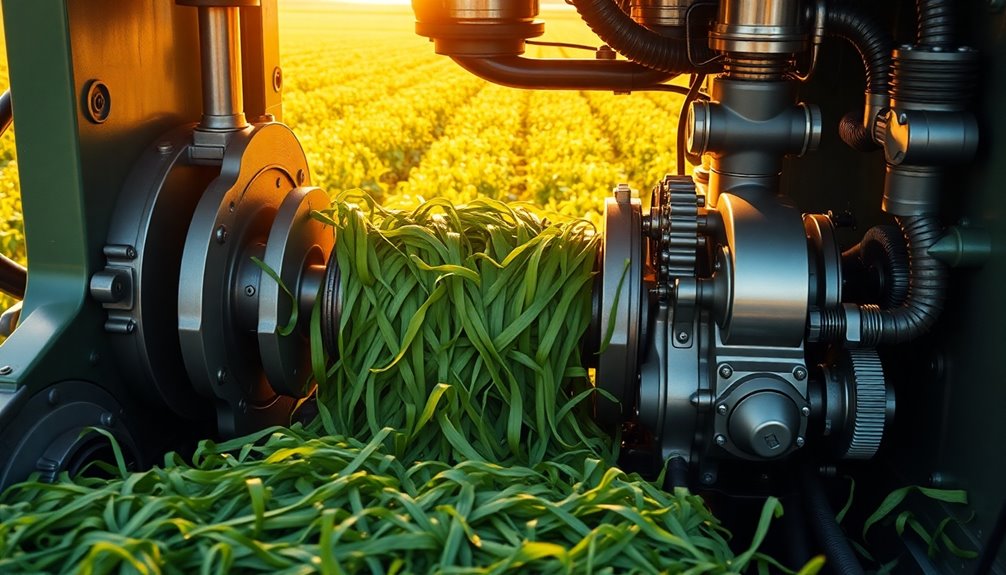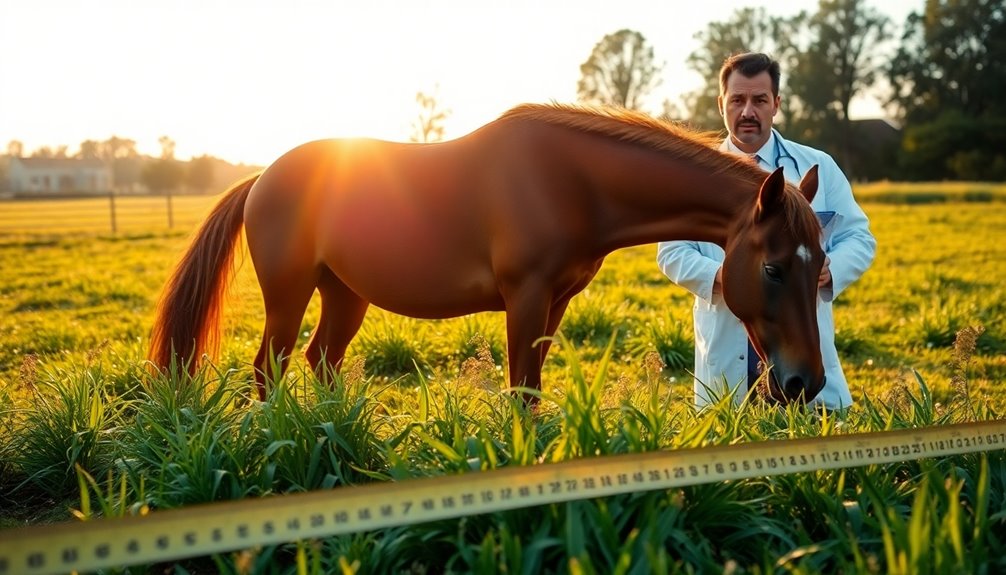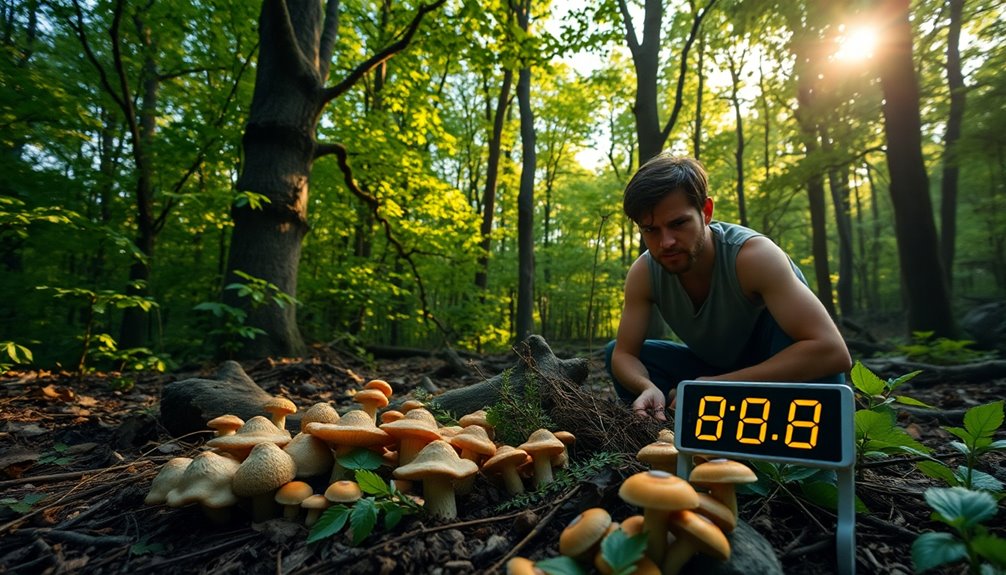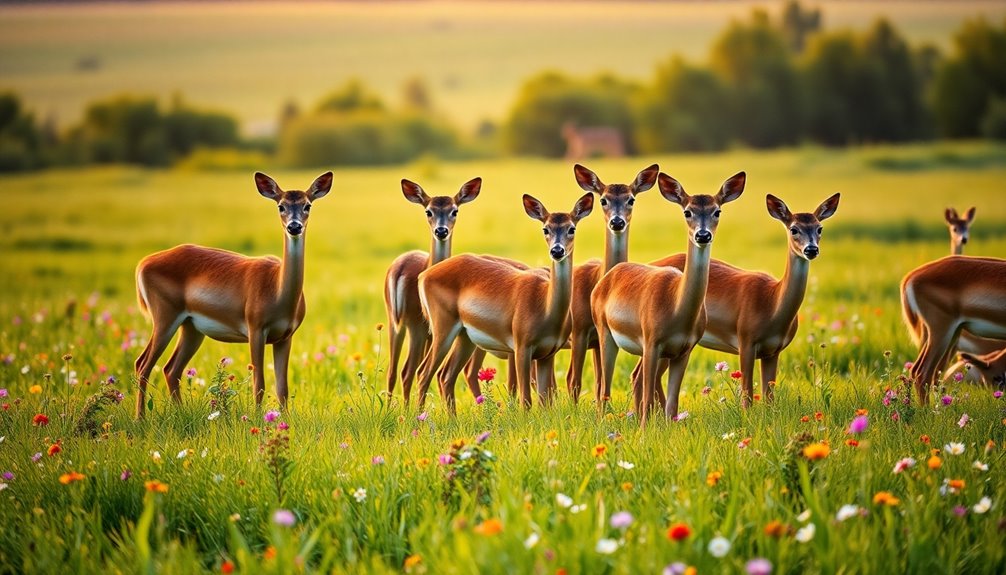Parrot owners, engage in the popular trend of making your own foraging toys. This hands-on activity not only helps keep your bird mentally stimulated, but also prevents boredom and encourages natural foraging behaviors. Make sure to use bird-safe and non-toxic materials to prioritize safety, and check for wear and tear regularly. Provide a variety of toys and closely supervise play for maximum engagement. Mix up treat sizes and introduce different levels of difficulty for added challenge. Boost problem-solving skills with toys that have moving parts and intricate designs. Delve into the world of parrot enrichment-it’s a fulfilling journey to enhance your pet’s well-being and happiness.
Key Takeaways
- DIY foraging toys provide mental stimulation and prevent boredom.
- Keep parrots engaged with interactive foot toys.
- Customize toys with safe materials to promote natural behaviors.
- Rotating and varying toy difficulty levels maintain parrot interest.
- Use diverse materials like coffee filters for engaging play.
Benefits of DIY Foraging Toys
Discover the numerous advantages of incorporating DIY foraging toys into your pet parrot's daily routine.
By engaging in the creation of these stimulating bird toys, you provide mental stimulation that's vital for your parrot's well-being. These toys offer more than just entertainment; they can prevent boredom and feather plucking while promoting physical activity.
Through safe materials, DIY foraging toys guarantee the safety of your feathered friend, giving you peace of mind. Not only do these toys keep your parrot physically active, but they also help build problem-solving skills, keeping their minds sharp and engaged.
Crafting these toys can be a cost-effective way to bond with your pet parrot, creating a strong connection between the two of you.
Embrace the benefits of DIY foraging toys, knowing that you're providing your parrot with essential mental stimulation and enrichment that will contribute to their overall happiness and well-being.
Essential Materials for Crafting

Utilize safe and bird-friendly items like natural wood, bamboo, and metal when gathering essential materials for crafting DIY foraging toys for your pet parrot. These materials are essential for guaranteeing the safety and well-being of your feathered friend while providing them with enriching play opportunities.
Here are some essential materials to contemplate:
- Natural Wood: Choose untreated wood like pine or fir, as it's vital for birds to chew on and interact with during playtime.
- Bamboo: Bamboo skewers or sticks can be used to create sturdy structures for hanging treats or toys, adding an element of challenge to the foraging experience.
- Metal: Opt for stainless steel or bird-safe metals to make sure that any hardware used in constructing the foraging toys is non-toxic and durable for long-term use.
Step-By-Step Toy Creation Guide

To create engaging foraging toys for your parrot, start by carefully selecting materials that are safe and stimulating.
Follow assembly instructions, such as securing coffee filters with rubber bands and drilling holes in wooden toys, to provide challenging tasks for your bird.
These DIY toys offer enrichment benefits by encouraging natural foraging behaviors and mental stimulation, promoting a healthy and happy parrot.
Toy Material Selection
When selecting materials for your DIY foraging toys for parrots, prioritize safety by choosing untreated wood, stainless steel, and natural fibers. These materials are bird-friendly and durable, ensuring your feathered friend can play without any harm.
Here are some key points to keep in mind:
- Untreated Wood: Opt for untreated wood to avoid exposing your parrot to harmful chemicals. Wood is excellent for beak exercise and mental stimulation.
- Stainless Steel: Stainless steel is a sturdy and safe material that can withstand the strong beak of your parrot. It's ideal for creating hooks or small components that require durability.
- Natural Fibers: Natural fibers like sisal or cotton ropes are great for adding texture and variety to your DIY foraging toys. They provide a safe chewing option for your parrot while encouraging natural behaviors.
Assembly Instructions
When creating your DIY foraging toy for your parrot, start by gathering materials such as coffee filters, rubber bands, wire, and bird-safe treats. Follow these step-by-step assembly instructions to make sure your bird enjoys a stimulating playtime that enhances its foraging skills:
| Step | Instructions |
|---|---|
| 1 | Secure coffee filters with rubber bands. |
| 2 | Leave openings in the filters for treats. |
| 3 | Customize hole sizes to challenge your bird. |
| 4 | Insert wire for hanging and add treats inside. |
Enrichment Benefits
Engage your pet parrot in mental stimulation and prevent boredom by creating DIY foraging toys using safe materials like coffee filters and wooden skewers. These toys not only keep your feathered friend entertained but also provide numerous enrichment benefits:
- Mental Stimulation: DIY foraging toys challenge your parrot's cognitive abilities, keeping their mind active and engaged.
- Physical Exercise: Encouraging your parrot to forage for treats inside the toys promotes physical activity, contributing to their overall health and well-being.
- Behavioral Enrichment: Customizing the foraging toys with different textures and challenges helps develop problem-solving skills in your bird, enhancing their quality of life.
Tips for Engaging Parrots

To keep your parrot mentally stimulated, consider incorporating a variety of engaging activities into their daily routine. One effective way to engage your parrot is by introducing foraging toys. These toys provide mental stimulation, prevent boredom, and encourage natural behaviors in your feathered friend. When using foraging toys, start with simple ones and use positive reinforcement during the training process. DIY foraging toy ideas can be fun and engaging, such as creating toys from safe materials like coffee filters and newspaper to keep your bird entertained.
Here is a table summarizing some tips for engaging your parrot:
| Tip | Description |
|---|---|
| Rotate foraging toys regularly | Switching up the toys can help maintain your parrot's interest and prevent habituation. |
| Offer a variety of foraging options | Provide different ways for your parrot to forage, like treat wrapping in cupcake liners, to keep them mentally engaged. |
| Supervise playtime with foraging toys | Keep an eye on your parrot while they interact with the toys to make sure safety and proper engagement. |
Ways to Increase Difficulty Levels
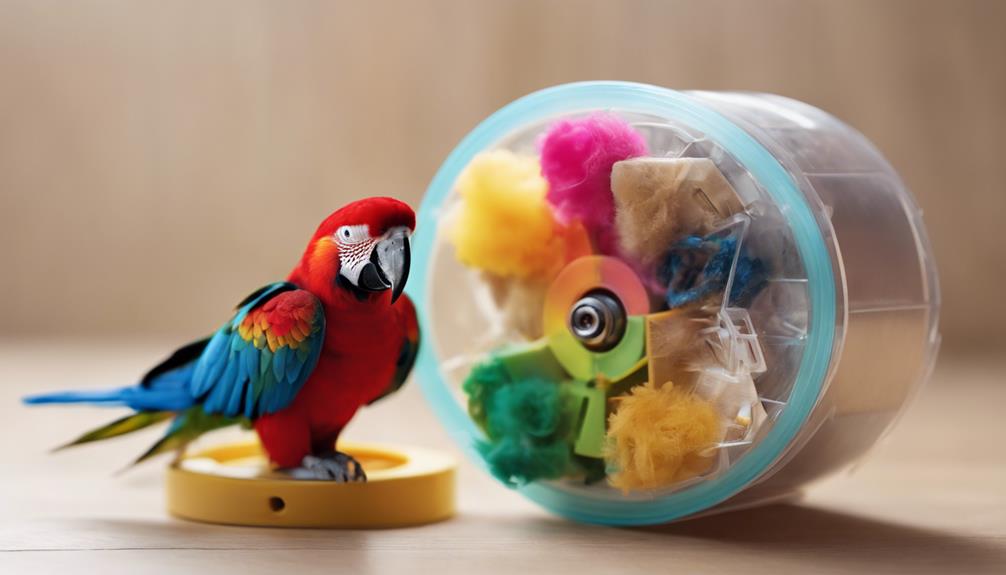
To enhance your parrot's mental stimulation and problem-solving abilities, consider gradually increasing the complexity of foraging toys through added compartments or obstacles. By incorporating various elements, you can keep your feathered friend engaged and entertained while encouraging their natural foraging instincts.
Here are some ways to increase the difficulty levels of your parrot's foraging toys:
- Vary Treat Sizes: Use treats of different sizes to make it more challenging for your parrot to retrieve them from the toy.
- Introduce Multiple Steps: Create foraging toys with multiple layers or steps that your parrot needs to navigate through to access the treat inside.
- Incorporate Moving Parts: Include mechanisms or parts that require manipulation to release or reveal the treat, adding an extra level of complexity to the toy.
Parrot-Approved Foraging Toy Designs
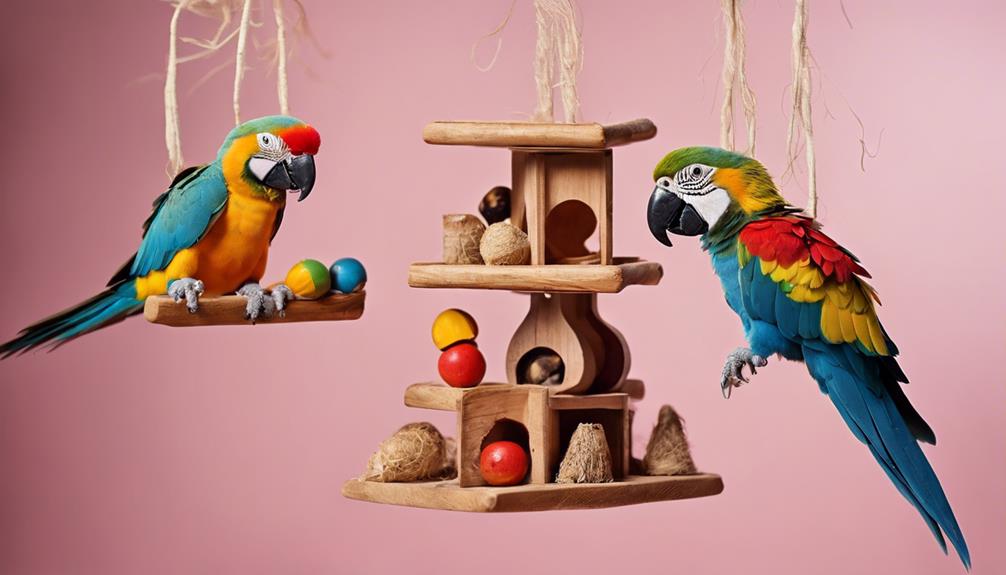
Consider incorporating parrot-approved foraging toy designs that stimulate your feathered friend's natural instincts and provide mental enrichment.
When creating toys for your birds, think about using coffee filters to wrap treats, offering both a challenge and reward. For visual appeal, opt for white or patterned cupcake liners that engage your parrot's senses.
DIY foraging toys can be easily crafted from newspaper or repurposed old toys with drilled holes for seeds, keeping your pet entertained and mentally sharp.
For a more advanced option, try making foraging toys from paper bags filled with enriching items to provide ample mental stimulation.
Remember to customize these toys with bird-safe materials and your parrot's favorite treats to make sure they stay engaged and happy.
Testimonials From Satisfied Parrot Owners

Parrot owners have shared glowing testimonials regarding the DIY foraging toy's positive impact on their feathered companions. Here are some key points highlighted by satisfied customers:
- Enhanced Mental Stimulation: Owners have noticed a significant improvement in their parrots' mental well-being since introducing the DIY foraging toy. The interactive nature of the toy keeps their pets engaged and mentally stimulated for hours on end.
- Prevention of Boredom: By providing a source of entertainment and challenge, the foraging toy effectively reduces boredom in parrots. This has led to a decrease in undesirable behaviors associated with boredom, such as excessive screaming or feather plucking.
- Promotion of Natural Foraging Behavior: The DIY toy encourages natural foraging instincts in pet birds, mimicking the activities they'd engage in the wild. This not only provides physical exercise but also fulfills their instinctual need to search for food, promoting overall well-being.
These testimonials emphasize the importance of mental stimulation and the positive impact of interactive foot toys like DIY foraging toys on parrots' lives.
Safety Precautions to Consider

When creating DIY foraging toys for your feathered friend, make sure to prioritize their safety by using bird-safe and non-toxic materials. Always supervise your bird when interacting with these toys to guarantee any potential hazards.
Monitor the foraging toys regularly for signs of wear and tear, as damaged parts could pose risks to your pet. Avoid incorporating small or sharp objects that may be swallowed or cause harm to the bird during playtime.
Consider your bird's size and behavior when designing or selecting DIY foraging toys to make sure they're appropriate and engaging. By being mindful of the materials used and the design of the toys, you can provide a safe and enjoyable experience for your feathered companion.
Frequently Asked Questions (Faqs)

FAQs are a valuable resource for understanding the benefits of DIY foraging toys for parrots and how they can enhance your bird's engagement.
These commonly asked questions cover essential topics such as the advantages of using foraging toys to keep your parrot mentally stimulated and physically active.
Toy Benefits
Enjoying a variety of foraging toys can greatly benefit your feathered friend by providing mental stimulation and promoting natural behaviors. When it comes to your pet birds, puzzle toys specifically offer numerous advantages:
- Mental Stimulation: Foraging toys engage your bird's cognitive abilities, keeping them mentally sharp and preventing boredom.
- Physical Activity: These toys encourage movement and exercise, which is essential for your bird's overall health and well-being.
- Problem-Solving Skills: By figuring out how to access treats hidden in the toys, your pet bird can enhance its problem-solving abilities and feel accomplished.
Incorporating puzzle toys into your bird's environment can help mimic their natural foraging instincts, leading to a happier and healthier companion.
Offering a variety of toys, including puzzles, balls, and boxes, allows you to cater to your specific bird species' needs while keeping them entertained and engaged.
Parrot Engagement
Engage your parrot with foraging toys to stimulate their natural behaviors and problem-solving skills. Providing mental stimulation through DIY foraging toys is essential for keeping your feathered friend entertained and preventing boredom. These toys not only offer a fun activity but also promote your parrot's overall well-being. By creating homemade foraging toys using simple materials like coffee filters, newspaper, and wooden skewers, you can customize the toys to suit your parrot's preferences and skill level.
Offering a variety of DIY foraging toys and techniques will help keep your parrot engaged and mentally stimulated. Through these interactive activities, your parrot can exhibit its natural behaviors while enhancing its cognitive abilities. Engaging your parrot with foraging toys encourages active participation and provides a healthy outlet for their energy. By incorporating these toys into your parrot's daily routine, you can create a stimulating environment that supports their mental and physical health.
Frequently Asked Questions
What Is a Home Made Toy for a Parrot?
To make a homemade toy for your parrot, gather safe materials like paper bags, cardboard boxes, and wooden blocks. Customize the toy to match your bird's preferences and intelligence level. DIY toys provide mental stimulation and enrichment for your pet.
What to Put in Parrot Foraging Toys?
You can fill foraging toys with neutral berries, nuts, or spray millets as treats. Use cupcake liners for wrapping them for extra fun. Incorporate white or patterned liners for visual stimulation. Place treats in their bowl or play gym for more foraging opportunities.
How Do You Make Homemade Parrot Foraging?
Create engaging homemade parrot foraging toys by repurposing materials like wood, paper, and fibers. Incorporate treats, seeds, and fruits for interaction. Adjust hole sizes for varying difficulty levels. Customize enrichment to suit your bird's preferences and abilities.
What Is Foraging for Parrots?
Foraging for parrots involves stimulating their natural instinct to hunt for food, providing mental and physical exercise. Different toys like puzzles and boxes challenge and entertain parrots, helping them stay healthy and preventing boredom.
Conclusion
To sum up, DIY foraging toys are a simple yet effective way to keep your parrot entertained and mentally stimulated. By using common household materials and following our step-by-step guide, you can easily create engaging toys that will keep your feathered friend happy and healthy.
So why wait? Start crafting today and watch as your parrot enjoys the challenge of foraging for treats in their new favorite toy.
Happy crafting!



